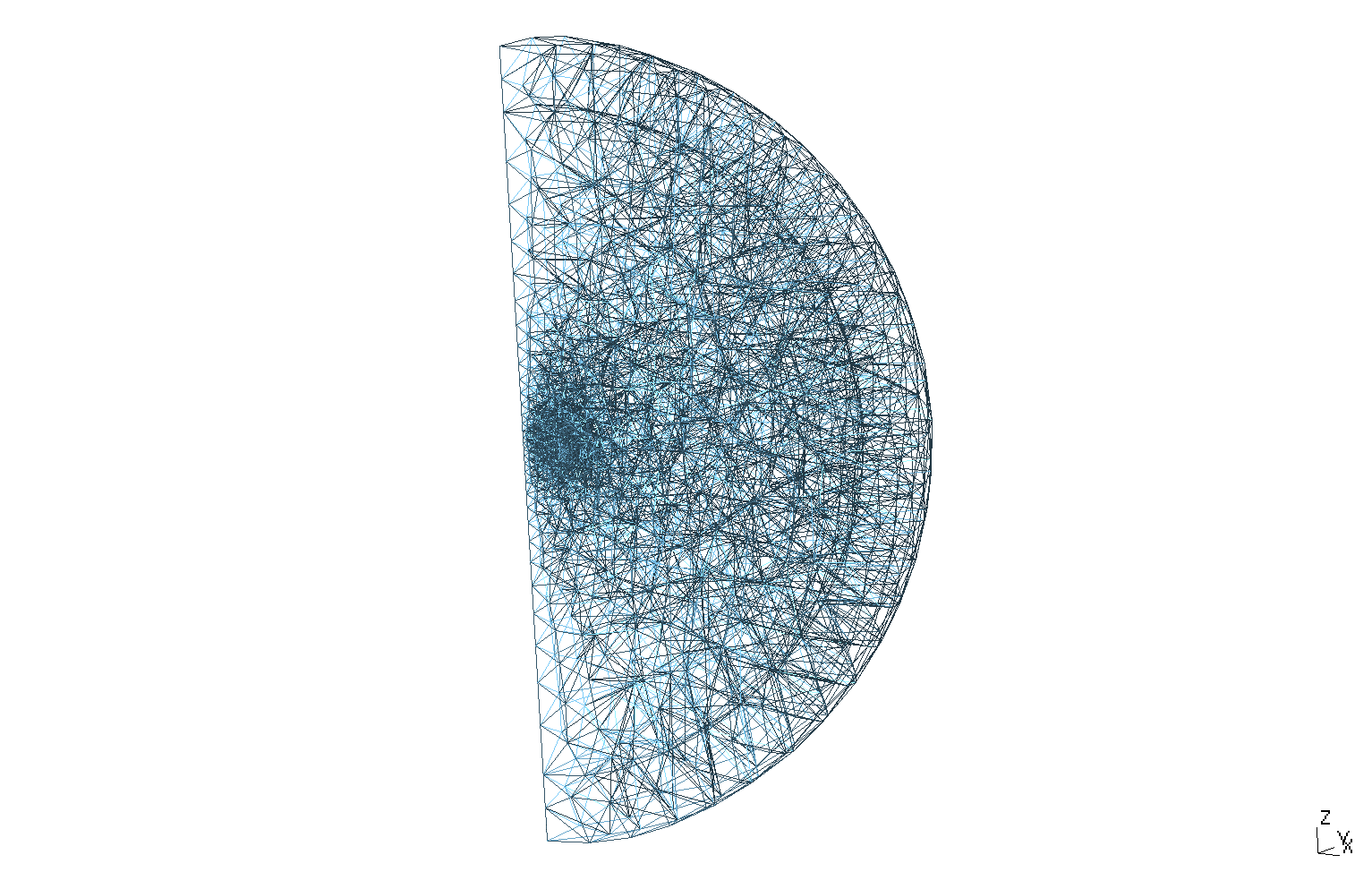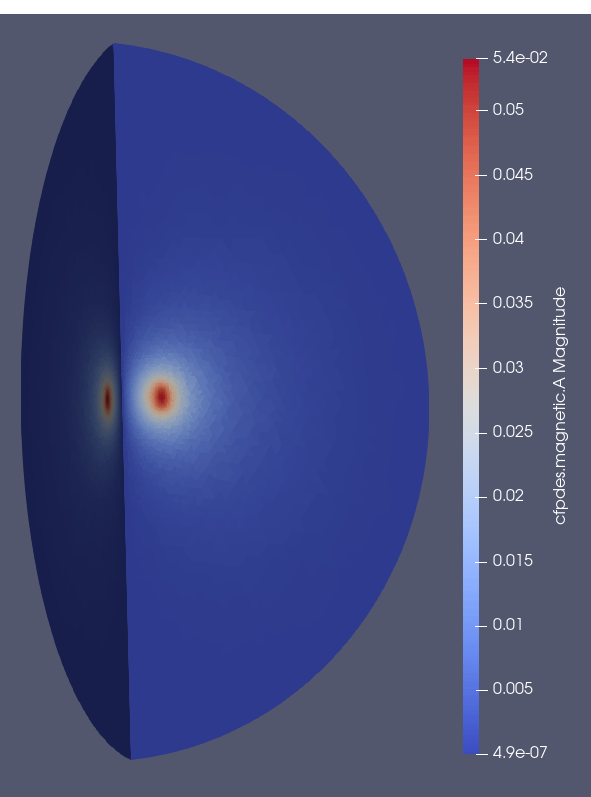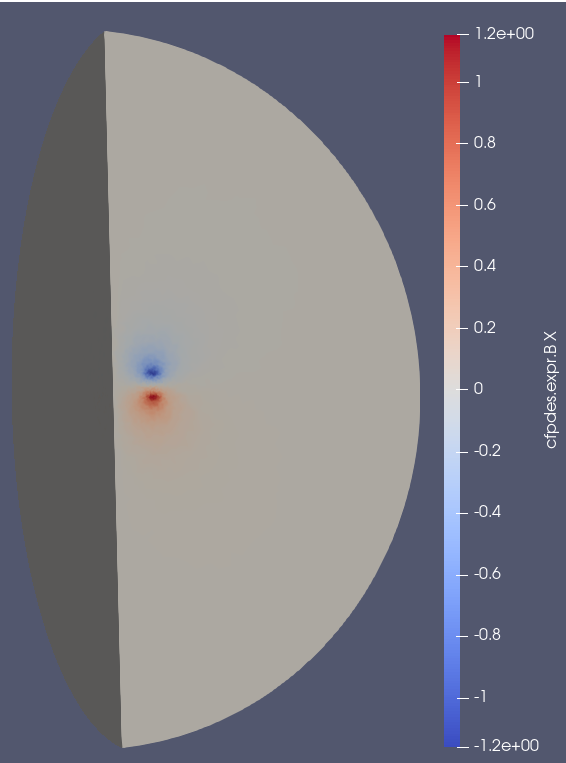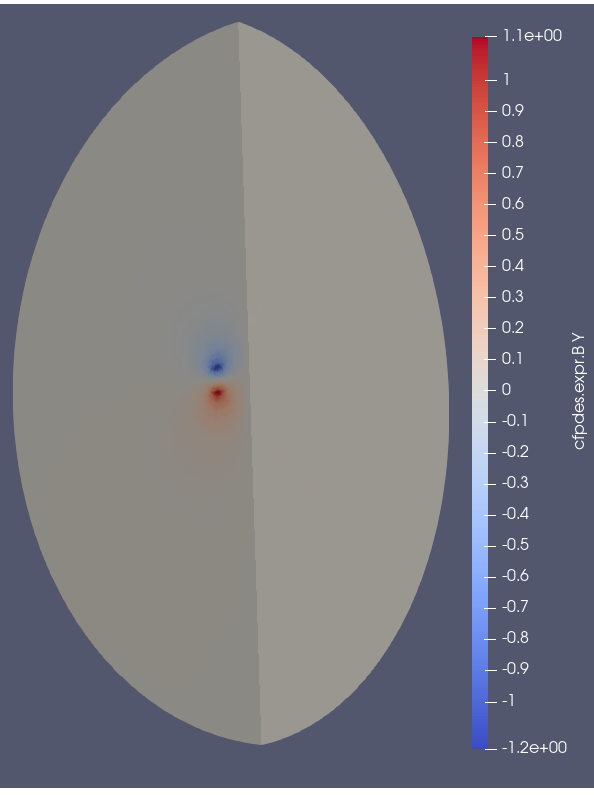Test Case of Magnetostatic with Saddle-Point Formulation on One Torus
1. Introduction
This is the test case of Maxwell Quasi Static Problem with the A-V Formulation and Gauge Condition on a torus geometry surrounded by air for the stationary case.
2. Run the Calculation
The command line to run this case is :
feelpp_toolbox_coefficientformpdes --config-file=magnetostatic_saddle.cfg --cfpdes.gmsh.hsize=5e-3
This case is run with the latest version 109 of Feelpp.
3. Data Files
The case data files are available in Github here :
-
CFG file - Edit the file
-
JSON file - Edit the file
-
GEO file - Edit the file
4. Equation
The domain \(\Omega\) is composed of the conductor \(\Omega_c\) and non conducting materials \(\Omega/\Omega_c\) where \(\mathbf{J} = 0\), like the air for example. \(\Gamma = \partial \Omega\) is the bound of \(\Omega\), decomposed in \(\Gamma_D\) with Dirichlet boundary condition and \(\Gamma_N\) with Neumann boundary condition, such that \(\Gamma = \Gamma_D \cup \Gamma_N\).
We introduce :
-
Magnetic potential field \(\mathbf{A}\) : the magnetic field is \(\textbf{B} = \nabla \times \textbf{A}\)
-
Electric potential scalar : \(\nabla V = - \textbf{E}\)
We have the conditions :
-
\(\nabla \cdot \mathbf{A} = 0\)
We want to resolve the electromagnetic problem ( with \(\mathbf{A}\), \(p\) and \(V\) as the unknowns) :
With :
-
\(\sigma\) : electric conductivity \(S/m\)
-
\(\mu\) : electric permeability \(kg/A^2/S^2\)
(See A-V Saddle-Point Formulation).
5. Geometry
The geometry is a quarter of a conducting torus, surrounded by air.

Geometry
|
The geometrical domains are :
-
Conductor: the torus, composed by a conductor-
V0: entrance of electrical potential -
V1: exit of electrical potential
-
-
Air: the air surroundingConductor-
OXOZ: \(OxOz\) plan -
OYOZ: \(OyOz\) plan -
Infty: the rest ofAir's bound
-
Symbol |
Description |
value |
unit |
\(r_{int}\) |
interior radius of torus |
\(75e-3\) |
m |
\(r_{ext}\) |
exterior radius of torus |
\(100.2e-3\) |
m |
\(z_1\) |
half-height of torus |
\(25e-3\) |
m |
\(r_{infty}\) |
radius of infty border |
\(5*r_{ext}\) |
m |
6. Boundary Conditions
The Dirichlet boundary conditions imposed are :
-
For \(V\) equation :
-
On
V0: \(V=0\) -
On
V1: \(V = \frac{1}{4}\)
-
-
For \(\mathbf{A}\) :
-
On
OXOZandV0: \(A_x = A_z = 0\), we want \(\mathbf{A}\) orthogonal toOXOZandV0 -
On
OYOZandV1: \(A_y = A_z = 0\), we want \(\mathbf{A}\) orthogonal toOYOZandV1 -
Infty: We approximate the problem,Inftyis the physical infty so \(\mathbf{B}=0\) atInftythus \(\mathbf{A} = 0\)
-
-
For \(p\) :
-
On
OXOZandV0: \(p = 0\) -
On
OYOZandV1: \(p = 0\) -
Infty: \(p = 0\)
-
On JSON file, the boundary conditions are written :
"BoundaryConditions":
{
"magnetic":
{
"Dirichlet":
{
"boundary":
{
"markers":["Infty"],
"expr":"{0,0,0}"
},
"mydir_x":
{
"markers":["V0","OXOZ"],
"expr":"{0,0,0}"
},
"mydir_y":
{
"markers":["V1","OYOZ"],
"expr":"{0,0,0}"
},
"mydir_z":
{
"markers":["V0","OXOZ","V1","OYOZ"],
"expr":"{0,0,0}"
}
}
},
"constraint":
{
"Dirichlet":
{
"boundary":
{
"markers":["Infty"],
"expr":"0"
},
"mydir_x":
{
"markers":["V0","OXOZ"],
"expr":"0"
},
"mydir_y":
{
"markers":["V1","OYOZ"],
"expr":"0"
},
"mydir_z":
{
"markers":["V0","OXOZ","V1","OYOZ"],
"expr":"0"
}
}
},
"electric":
{
"Dirichlet":
{
"V0":
{
"markers":["V0"],
"expr":"V0:V0"
},
"V1":
{
"markers":["V1"],
"expr":"V1:V1"
}
}
}
},
7. Weak Formulation
8. Parameters
The parameters of the problem are :
-
On
Conductor:
Symbol |
Description |
Value |
Unit |
\(V0\) |
scalar electrical potential on |
\(0\) |
\(Volt\) |
\(V1\) |
scalar electrical potential on |
\(\frac{1}{4}\) |
\(Volt\) |
\(\sigma\) |
electrical conductivity |
\(58e6\) |
\(S/m\) |
\(\mu=\mu_0\) |
magnetic permeability of vacuum |
\(4\pi.10^{-7}\) |
\(kg \, m / A^2 / S^2\) |
-
On
Air:
Symbol |
Description |
Value |
Unit |
\(\mu=\mu_0\) |
magnetic permeability of vacuum |
\(4\pi.10^{-7}\) |
\(kg \, m / A^2 / S^2\) |
On JSON file, the parameters are written :
"Parameters":
{
"V0":0,
"V1":"1/4*1",
"sigma":58e6,
"mu":"4*pi*1e-7"
},
9. Coefficient Form PDEs
The Feelpp toolboxe Coefficient Form PDEs is used here. The coefficients associated to the Weak Formulation are :
-
On
Conductor:
Coefficient |
Description |
Expression |
|
curlcurl coefficient |
\(\frac{1}{\mu}\) |
|
source term |
\(-\nabla p - \sigma \nabla V \) |
|
damping or mass coefficient |
\(\sigma\) |
|
conservative flux source term |
\(\mathbf{A}\) |
-
On
Air:
Coefficient |
Description |
Expression |
|
curlcurl coefficient |
\(\frac{1}{\mu}\) |
|
source term |
\(-\nabla p\) |
|
conservative flux source term |
\(\mathbf{A}\) |
On JSON file, the coefficients are written :
"Materials":
{
"Conductor":
{
"magnetic_zeta":"1/mu:mu",
"magnetic_f":"{-constraint_grad_p_0-sigma*electric_grad_V_0,-constraint_grad_p_1-sigma*electric_grad_V_1,-constraint_grad_p_2-sigma*electric_grad_V_2}:sigma:electric_grad_V_0:electric_grad_V_1:electric_grad_V_2:constraint_grad_p_0:constraint_grad_p_1:constraint_grad_p_2",
"electric_c":"sigma:sigma",
"constraint_gamma":"{magnetic_A_0,magnetic_A_1,magnetic_A_2}:magnetic_A_0:magnetic_A_1:magnetic_A_2"
},
"Air":
{
"physics":["magnetic","constraint"],
"magnetic_zeta":"1/mu:mu",
"magnetic_f":"{-constraint_grad_p_0,-constraint_grad_p_1,-constraint_grad_p_2}:constraint_grad_p_0:constraint_grad_p_1:constraint_grad_p_2",
"constraint_gamma":"{magnetic_A_0,magnetic_A_1,magnetic_A_2}:magnetic_A_0:magnetic_A_1:magnetic_A_2"
}
},
10. Numeric Parameters
This section shows the parameters used to compute the simulation.
-
Size of mesh :
-
On
Conductor: \(0.5 \, mm\) -
On
Infty: \(100 \, mm\)
-

Mesh of Geometry
|
11. Results
11.1. Magnetic Potential Field
The magnetic potential field \(\mathbf{A}\) :

\(A (T.m)\)
|
The behavior of \(A\) on the \(O_r\) axis is as follows :
h |
L2 Error Norm |
L2 Relative Error Norm |
\(1e-2\) |
\(9.78512e-3\) |
\(6.61\%\) |
\(7e-3\) |
\(8.03447e-3\) |
\(5.43\%\) |
\(5e-3\) |
\(5.21347e-3\) |
\(3.52\%\) |
\(4e-3\) |
\(4.96288e-3\) |
\(3.36\%\) |
11.2. Magnetic Field
The magnetic field \(\mathbf{B}\) is defined by :

\(B_x (T)\) on Or axis
|

\(B_y (T)\) on Or axis
|
The behavior of \(\mathbf{B}_z\) on the \(O_z\) axis :
h |
L2 Error Norm |
L2 Relative Error Norm |
\(1e-2\) |
\(18.417352e-2\) |
\(7.27\%\) |
\(7e-3\) |
\(8.989375e-2\) |
\(3.55\%\) |
\(5e-3\) |
\(8.358335e-2\) |
\(3.3\%\) |
\(4e-3\) |
\(5.451477e-2\) |
\(2.15\%\) |
12. References
-
Cecile Daversin - Catty. Reduced basis method applied to large non-linear multi-physics problems: application to high field magnets design. Electromagnetism. Université de Strasbourg, 2016. p56-64 PDF